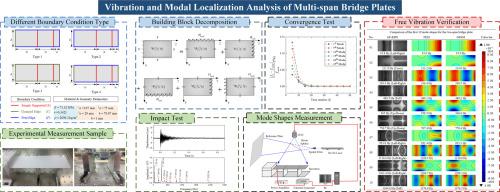多跨桥梁板动态行为的新型解决方案
IF 7.1
1区 工程技术
Q1 ENGINEERING, MECHANICAL
International Journal of Mechanical Sciences
Pub Date : 2024-10-30
DOI:10.1016/j.ijmecsci.2024.109798
引用次数: 0
摘要
本文通过分析方法、数值模拟和实验测量,对多跨桥梁板结构的自由振动特性进行了全面分析,并讨论了多跨桥梁板结构的模态局部化现象。首先提出了一种使用广义叠加段法(GSSM)研究多跨桥梁横向振动的新型解析解,该方法在描述任意经典边界条件时具有完全的灵活性。此外,新的实验装置实现了精确的简支撑边界条件,并采用了两跨和三跨桥梁板的缩放物理模型来验证分析解决方案。通过分析不同跨度的多跨桥板的共振频率和模态振型,研究了跨度不匹配的影响。理论分析、数值模拟和实验测量结果的良好一致性表明,所提出的解析解能够有效地解决多跨桥梁板的振动问题,并能反映真实世界的边界条件。最后,在理论分析和实验测量中观察到了两种模态定位行为。通过分析求解、数值模拟和实验测量,本研究加深了对多跨桥梁动态行为的理解。它为预测多跨桥梁系统的振动提供了一个新的理论基准,并为多跨桥梁板的瞬态行为提供了有用的见解,为今后的研究提出了一些富有成效的途径,包括探索被动和主动控制系统以及振动抑制技术。本文章由计算机程序翻译,如有差异,请以英文原文为准。

A novel solution for dynamic behaviors of multi-span bridge plates
The present paper draws a comprehensive analysis of the free vibration characteristics and discusses modal localization phenomena of multi-span bridge plate structures through an analytical method, numerical simulations, and experimental measurements. A novel analytical solution using the generalized superposition segment method (GSSM) is first proposed to investigate the transverse vibration of a multi-span bridge, which offers complete flexibility in describing arbitrarily classical boundary conditions. Furthermore, a new experimental setup achieves precisely simply supported boundary conditions, and scaled physical models of two- and three-span bridge plates are employed to validate the analytical solution. The effect of span length mismatch is studied by analyzing the resonant frequencies and mode shapes of a multi-span bridge plate with varying span lengths. The good consistency of results by theoretical analysis, numerical simulation, and experimental measurements indicate that the proposed analytical solution can solve the vibration problem of the multi-span bridge plate efficiently and reflect the real-world boundary condition. Finally, the two modal localization behaviors are observed in theoretical analysis and experimental measurement. Through analytical solutions, numerical simulations, and experimental measurements, this study enhances the understanding of the dynamic behavior of multi-span bridges. It provides a new theoretical benchmark for predicting vibrations of multi-span bridge systems and useful insights into the transient behavior of multi-span bridge plates, suggesting several fruitful avenues for future research, including exploring passive and active control systems and vibration suppression techniques.
求助全文
通过发布文献求助,成功后即可免费获取论文全文。
去求助
来源期刊

International Journal of Mechanical Sciences
工程技术-工程:机械
CiteScore
12.80
自引率
17.80%
发文量
769
审稿时长
19 days
期刊介绍:
The International Journal of Mechanical Sciences (IJMS) serves as a global platform for the publication and dissemination of original research that contributes to a deeper scientific understanding of the fundamental disciplines within mechanical, civil, and material engineering.
The primary focus of IJMS is to showcase innovative and ground-breaking work that utilizes analytical and computational modeling techniques, such as Finite Element Method (FEM), Boundary Element Method (BEM), and mesh-free methods, among others. These modeling methods are applied to diverse fields including rigid-body mechanics (e.g., dynamics, vibration, stability), structural mechanics, metal forming, advanced materials (e.g., metals, composites, cellular, smart) behavior and applications, impact mechanics, strain localization, and other nonlinear effects (e.g., large deflections, plasticity, fracture).
Additionally, IJMS covers the realms of fluid mechanics (both external and internal flows), tribology, thermodynamics, and materials processing. These subjects collectively form the core of the journal's content.
In summary, IJMS provides a prestigious platform for researchers to present their original contributions, shedding light on analytical and computational modeling methods in various areas of mechanical engineering, as well as exploring the behavior and application of advanced materials, fluid mechanics, thermodynamics, and materials processing.
 求助内容:
求助内容: 应助结果提醒方式:
应助结果提醒方式:


